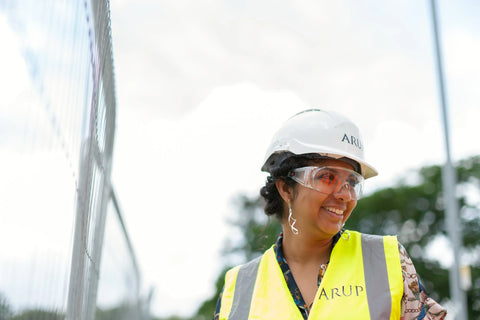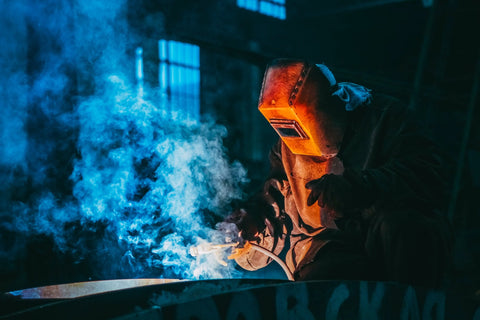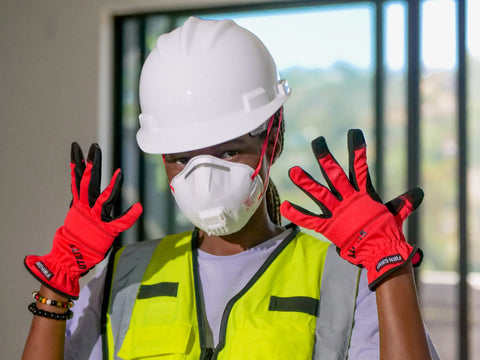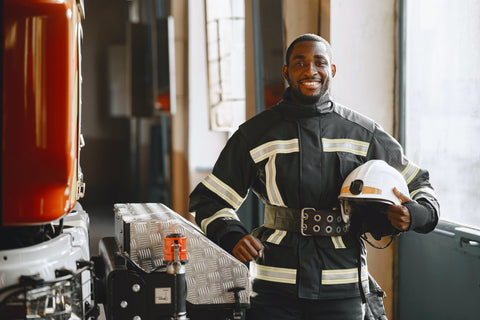Choosing the Right Safety Gear for Industrial Workplaces
Welcome to our guide on choosing the right industrial safety gear for your workplace. In any industrial setting, worker safety should always be a top priority. With the right equipment and protection, you can prevent accidents and injuries from occurring.
Industrial safety gear is designed to protect workers from potential hazards in their workplace. It includes a range of equipment such as helmets, goggles, gloves, and respirators. It's important to know which gear is necessary for your specific workplace and job tasks to ensure the highest level of protection.

Understanding the Hazards in Your Workplace
Before selecting appropriate safety gear, it's crucial to have a thorough understanding of the potential hazards in your workplace. A safety assessment is an effective way to identify possible hazards which can then be managed through risk management strategies.
Factors to consider when assessing your workplace include the types of machinery and equipment used, the materials being handled, and the potential for slips, trips and falls. It is also important to consider environmental factors such as noise levels, temperature extremes, and exposure to hazardous substances.
In addition to conducting a safety assessment, it's important to stay up-to-date with relevant safety regulations and standards. These regulations vary by industry and country, and can impact the selection and use of safety gear in the workplace.
Examples of Workplace Hazards
Some of the most common workplace hazards include falls from height, electrocution, cuts and lacerations, and exposure to hazardous chemicals. These hazards can cause serious injuries or even fatalities if appropriate safety gear is not worn or safety procedures are not followed.
For example, a worker who is exposed to harmful chemicals without adequate respiratory protection may develop respiratory problems or illnesses over time. Similarly, failure to wear appropriate eye protection can lead to serious eye injuries from flying debris or chemical splashes.
By conducting a safety assessment and identifying potential hazards, employers and workers can take the necessary steps to prevent accidents and ensure a safe work environment. Appropriate safety gear such as hard hats, safety goggles, earplugs, and respirators can provide essential protection against workplace hazards.
Head Protection Gear

Head protection gear is essential for industrial workers as it helps prevent head injuries that can result from falling objects, electrical hazards, or other harmful incidents in the workplace.
The most common types of head protection gear are hard hats and safety helmets. Hard hats are suitable for protection against falling objects, while safety helmets offer additional protection against electrical hazards. Both types of head protection gear should be worn whenever a worker is at risk of head injury on the job.
It is important to note that head protection gear should meet all relevant safety regulations and standards. This includes having proper suspension systems, a secure fit, and the ability to absorb impact.
Failure to wear head protection gear in industrial workplaces can lead to severe head injuries or even fatalities. Therefore, it is critical to ensure that workers have access to suitable and comfortable head protection gear, and that it is worn at all times when required.
Types of Head Injuries
Head injuries can have serious consequences and should never be taken lightly. In industrial workplaces, head injuries can occur due to falling objects, impact from equipment, or electrical hazards. Symptoms can range from mild, such as a headache and dizziness, to severe, such as loss of consciousness, cognitive impairment, or even death.
Types of head injuries that can occur in industrial workplaces include:
- Concussions
- Lacerations
- Fractures
- Skull injuries
- Brain injuries
These injuries can be prevented by wearing suitable head protection gear, as well as identifying and mitigating workplace hazards.
Personal Protective Equipment (PPE)
Personal protective equipment, or PPE, is designed to protect workers from hazards in the workplace. When it comes to head protection gear, there are many different types of PPE available, including:
- Hard hats
- Safety helmets
- Baseball caps with inserts for impact protection
- Bump caps
- Hoods and hairnets
It is important to choose the right type of PPE for the job and ensure that it is worn correctly. PPE should fit comfortably and securely, and workers should be trained on how to use it properly.
Eye and Face Protection Gear

Eye and face protection is crucial for industrial workers who are exposed to dust, debris, chemicals, and other hazards that can cause serious eye injuries. In fact, according to the Bureau of Labor Statistics, eye injuries account for nearly 40% of all face injuries in the workplace.
There are several types of eye and face protection gear designed to protect workers from different types of hazards. Safety goggles are designed to protect workers from dust, debris, and other small particles that could cause eye irritation or injury. Face shields provide protection from larger projectiles and chemical splashes, and are often worn in conjunction with safety goggles for added protection.
Types of Eye Injuries
Eye injuries in the workplace can range from minor irritations to permanent blindness. Some common types of eye injuries that can occur include:
- Corneal abrasions
- Chemical burns
- Foreign objects in the eye
- Penetrating injuries
Any of these injuries can be prevented by wearing the appropriate eye and face protection gear.
Choosing the Right Eye and Face Protection Gear
When choosing eye and face protection gear, it is important to consider the specific hazards present in your workplace. Safety goggles are perfect for protecting against dust and small particles, while face shields are more appropriate for larger projectiles and chemical splashes. Some hazards may require a combination of both types of protection.
Expert Tip: Always choose eye and face protection gear that meets the appropriate safety standards and regulations.
Additionally, it is important to ensure that the eye and face protection gear fits properly and is comfortable to wear. Ill-fitting gear can be a distraction and may not provide adequate protection.
Conclusion
Eye and face protection gear is essential for ensuring worker safety in industrial workplaces. By understanding the different types of hazards that can cause eye injuries and choosing the appropriate protection gear, employers can help prevent workplace accidents and injuries.
Hearing Protection Gear
Exposure to loud noises in industrial workplaces can lead to permanent hearing damage. This is why it is crucial to wear appropriate hearing protection gear. Here, we will discuss the different types of hearing protection gear available.
Earplugs
Earplugs are small devices that are inserted into the ear canal to reduce the amount of noise that enters the ear. They come in different sizes and materials to fit various ear sizes and preferences. Disposable earplugs are often made of foam and are inexpensive. On the other hand, reusable earplugs are made of silicone or rubber and can be cleaned and reused multiple times.
Earmuffs
Earmuffs are another type of hearing protection gear that cover the entire ear. They consist of soft cushions that form a seal around the ear to reduce the amount of noise that enters. Earmuffs come in different designs and sizes to fit various head sizes and preferences. Some earmuffs are equipped with built-in communication systems or music players to allow workers to stay connected while wearing them.
Hearing Loss Prevention
Hearing loss is an irreversible condition, which is why prevention is key. To prevent hearing damage, it is important to wear appropriate hearing protection gear when in noisy environments. It is also important to take breaks from noisy environments to give the ears time to rest. Employers should also implement engineering controls, such as noise barriers and sound-absorbing materials, to reduce noise levels in the workplace.
By wearing appropriate hearing protection gear and implementing noise reduction measures, workers can prevent hearing damage and enjoy better quality of life.
Respiratory Protection Gear

Respiratory hazards are a serious concern in many industrial workplaces, and employees must take steps to protect themselves from harm. Respiratory protection gear, which includes respirators and dust masks, can significantly reduce the risks of inhaling harmful substances and particles.
Types of Respiratory Protection Gear
Respiratory protection gear comes in different styles and levels of protection. The type of gear you need depends on the nature of the respiratory hazard present in your workplace. Respirators are the most common type of respiratory protection gear and come in different models, such as half-mask respirators, full-face respirators, and powered air-purifying respirators (PAPRs). Dust masks, on the other hand, protect workers from harmful dust particles and are best suited for low-risk environments.
When choosing respiratory protection gear, it is important to consider comfort, proper fit, and ease of use. Workers should be trained on how to properly wear and use the gear, including how to properly don and doff the respirator.
The Importance of Respiratory Protection Gear
Inhaling harmful particles and substances can cause serious respiratory problems such as asthma, lung cancer, and other lung diseases. Respiratory protection gear is essential in minimizing exposure to these risks. Employers are required to provide respiratory protection gear to workers in high-risk environments and to ensure that the gear is properly maintained and replaced when necessary.
Workers should always use respiratory protection gear when required, and they should immediately report any respiratory symptoms or problems to their supervisor. It is also important to follow proper maintenance and storage procedures for respiratory protection gear to ensure that it is always ready for use when needed.
Body Protection Gear

Industrial workplaces can have a range of hazards that can cause injuries to the body, including cuts, burns, and punctures. It is crucial to wear the appropriate gear to protect your body from these types of injuries. In this section, we will discuss body protection gear options available for industrial workers.
Safety Vests
Safety vests are essential in workplaces where workers are exposed to moving vehicles or equipment. These vests come in different colors, including fluorescent colors and reflective materials, providing better visibility to workers. They can also have pockets for carrying small tools or equipment.
Coveralls
Coveralls are designed to protect the whole body from hazardous materials such as chemicals, dust, and fibers. They can be made from materials that are disposable or reusable, and can have hoods and boots attached. They provide a barrier against harmful particles from getting on the worker's clothes and body.
Gloves
Gloves can offer protection against hand injuries in industrial workplaces. Different gloves are made to protect the hands from different types of hazards, such as cuts, punctures, and chemicals. Workers should choose gloves that fit them well and are appropriate for the type of work they are doing.
FAQ
What is PPE?
PPE stands for Personal Protective Equipment. It refers to wearable equipment designed to protect workers from hazards that may cause injuries or illnesses in the workplace.
What type of body protection gear should I wear?
The type of body protection gear you should wear depend on the type of work you do and the hazards present in your workplace. Consult with your safety officer to determine the appropriate gear for your job.
How do I know if my body gear is the right size?
Your body gear should fit you snugly without being too tight or too loose. If it is too tight, it may restrict your movements or cause discomfort. If it is too loose, it may not offer adequate protection. Refer to the manufacturer's sizing chart to find the right fit.
How often should I replace my body protection gear?
You should replace your body protection gear if it becomes torn, damaged, or shows signs of wear and tear. Refer to the manufacturer's guidelines to determine the lifespan of your gear.
What is industrial safety gear?
Industrial safety gear refers to the equipment worn by workers to protect them from hazards in the workplace.
What are some common types of industrial safety gear?
Common types of industrial safety gear include hard hats, safety goggles, face shields, earplugs, earmuffs, respirators, safety vests, coveralls, and gloves.
Why is it important to wear safety gear in industrial workplaces?
Industrial workplaces can be dangerous, with potential hazards including head injuries, eye injuries, hearing loss, respiratory damage, and body injuries. Wearing safety gear can help protect workers from these hazards and prevent workplace accidents.
How do I choose the right safety gear for my workplace?
Choosing the right safety gear requires a thorough assessment of your workplace and identification of potential hazards. Consult with safety experts or suppliers to ensure you are purchasing the appropriate gear for your workplace needs.
What are some common mistakes people make when using industrial safety gear?
Some common mistakes include not wearing safety gear at all times, failing to properly adjust or fit safety gear, and not replacing damaged or outdated gear. It's important to follow manufacturer instructions and regularly inspect and maintain safety gear.
Can PPE completely eliminate workplace hazards?
While wearing PPE can significantly reduce the risk of workplace injuries or accidents, it cannot completely eliminate hazards. Employers should also implement engineering and administrative controls to further minimize workplace risks.
What are some common safety regulations related to industrial safety gear?
Regulations vary by industry and location, but common safety standards include those set by the Occupational Safety and Health Administration (OSHA) and the National Institute for Occupational Safety and Health (NIOSH).
How often should I inspect and replace my safety gear?
Safety gear should be regularly inspected for signs of damage or wear, and should be replaced as soon as any issues are identified. The frequency of inspections and replacements will depend on the specific type of gear and workplace conditions.
Remember, prioritizing safety in the workplace is crucial for protecting workers and preventing accidents. Consult with safety experts and invest in appropriate safety gear to ensure a safe and healthy work environment.
